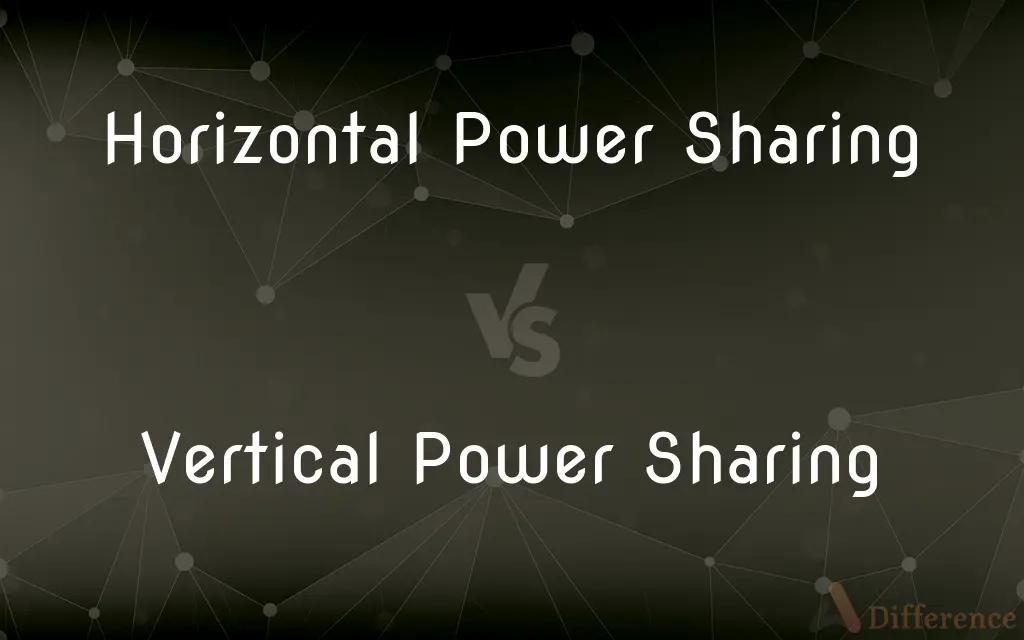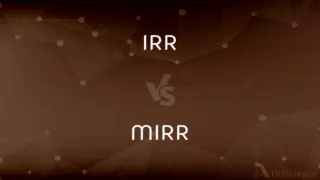Horizontal Power Sharing vs. Vertical Power Sharing — What's the Difference?
Edited by Tayyaba Rehman — By Fiza Rafique — Published on December 28, 2023
Horizontal Power Sharing divides authority among different branches of government, while Vertical Power Sharing distributes power between central and regional governments.

Difference Between Horizontal Power Sharing and Vertical Power Sharing
Table of Contents
ADVERTISEMENT
Key Differences
Horizontal Power Sharing refers to the distribution of power among different branches of government, such as the executive, legislative, and judiciary. This ensures that no single entity or branch has absolute control, promoting checks and balances. On the other hand, Vertical Power Sharing involves the allocation of power between the central government and its subunits, often regional or local governments. This form of power sharing respects the principle of subsidiarity, where decisions are made as close to the local level as possible.
Horizontal Power Sharing primarily ensures that power does not become concentrated, which could lead to authoritarian tendencies. Vertical Power Sharing, in contrast, brings governance closer to the people, accommodating diversity and local needs. While Horizontal Power Sharing creates a system of oversight among government branches, Vertical Power Sharing fosters cooperation and coordination between different levels of government.
Comparison Chart
Definition
Distribution among government branches
Allocation between central and regional governments
Purpose
Checks and balances
Bring governance closer to people
Primary Entities Involved
Executive, Legislative, Judiciary
Central, State/Regional, Local governments
ADVERTISEMENT
Examples
U.S. separation of powers
U.S. Federalism; Central and State governments in India
Associated Principles
Separation of powers
Subsidiarity
Compare with Definitions
Horizontal Power Sharing
Maintains oversight and accountability.
Through Horizontal Power Sharing, the judiciary can check the executive's actions.
Vertical Power Sharing
Allocation of authority between central and sub-governments.
In India, Vertical Power Sharing exists between the central and state governments.
Horizontal Power Sharing
Prevents concentration of power.
The principle of Horizontal Power Sharing keeps democracy healthy and functional.
Vertical Power Sharing
Facilitates decentralized governance.
Vertical Power Sharing promotes decision-making at the most appropriate level.
Horizontal Power Sharing
Ensures checks and balances.
Horizontal Power Sharing prevents any one branch from gaining absolute control.
Vertical Power Sharing
Respects regional and local diversity.
Vertical Power Sharing ensures that regional cultures and traditions are considered in governance.
Horizontal Power Sharing
Distribution of authority among government branches.
The U.S. Constitution emphasizes Horizontal Power Sharing through its separation of powers.
Vertical Power Sharing
Encourages autonomy at different levels.
States enjoy a degree of autonomy due to Vertical Power Sharing.
Horizontal Power Sharing
Facilitates coordination among branches.
Horizontal Power Sharing requires branches to work together, ensuring cohesive governance.
Vertical Power Sharing
Brings governance closer to people.
Local governments benefit directly from Vertical Power Sharing.
Common Curiosities
Why is Vertical Power Sharing important for large countries?
It ensures that diverse regions and localities have a say in governance.
What does Horizontal Power Sharing entail?
It refers to the distribution of power among different branches of government.
Do all countries practice Vertical Power Sharing?
No, not all countries have a system that distributes power between central and regional entities.
Can Vertical Power Sharing exist without Horizontal Power Sharing?
Yes, they are independent concepts, though many countries adopt both.
Which country is a classic example of Horizontal Power Sharing?
The U.S., with its clear separation of powers, exemplifies Horizontal Power Sharing.
Which branch often checks the others in Horizontal Power Sharing?
The judiciary frequently checks the executive and legislative branches.
How does Vertical Power Sharing affect local governance?
Vertical Power Sharing brings governance closer to the people by allocating authority to local and regional governments.
Which principle is closely associated with Horizontal Power Sharing?
The principle of checks and balances.
Why is Horizontal Power Sharing crucial for democracies?
It prevents the concentration of power, which could lead to authoritarianism.
Can a country have both Horizontal and Vertical Power Sharing?
Yes, many democracies, like the U.S., incorporate both forms of power sharing.
How does Horizontal Power Sharing influence policy-making?
It requires coordination among branches, ensuring well-rounded policies.
Why might regions demand more Vertical Power Sharing?
To ensure their local needs, culture, and traditions are adequately represented and addressed.
How does Vertical Power Sharing support regional identities?
By giving regional governments authority, it respects and accommodates regional differences.
Is federalism related to Vertical Power Sharing?
Yes, federalism is a form of Vertical Power Sharing between central and state governments.
What prevents one branch from becoming too powerful in Horizontal Power Sharing?
The system of checks and balances ensures mutual oversight among branches.
Share Your Discovery

Previous Comparison
IRR vs. MIRR
Next Comparison
Prairie Dog vs. GroundhogAuthor Spotlight
Written by
Fiza RafiqueFiza Rafique is a skilled content writer at AskDifference.com, where she meticulously refines and enhances written pieces. Drawing from her vast editorial expertise, Fiza ensures clarity, accuracy, and precision in every article. Passionate about language, she continually seeks to elevate the quality of content for readers worldwide.
Edited by
Tayyaba RehmanTayyaba Rehman is a distinguished writer, currently serving as a primary contributor to askdifference.com. As a researcher in semantics and etymology, Tayyaba's passion for the complexity of languages and their distinctions has found a perfect home on the platform. Tayyaba delves into the intricacies of language, distinguishing between commonly confused words and phrases, thereby providing clarity for readers worldwide.














































